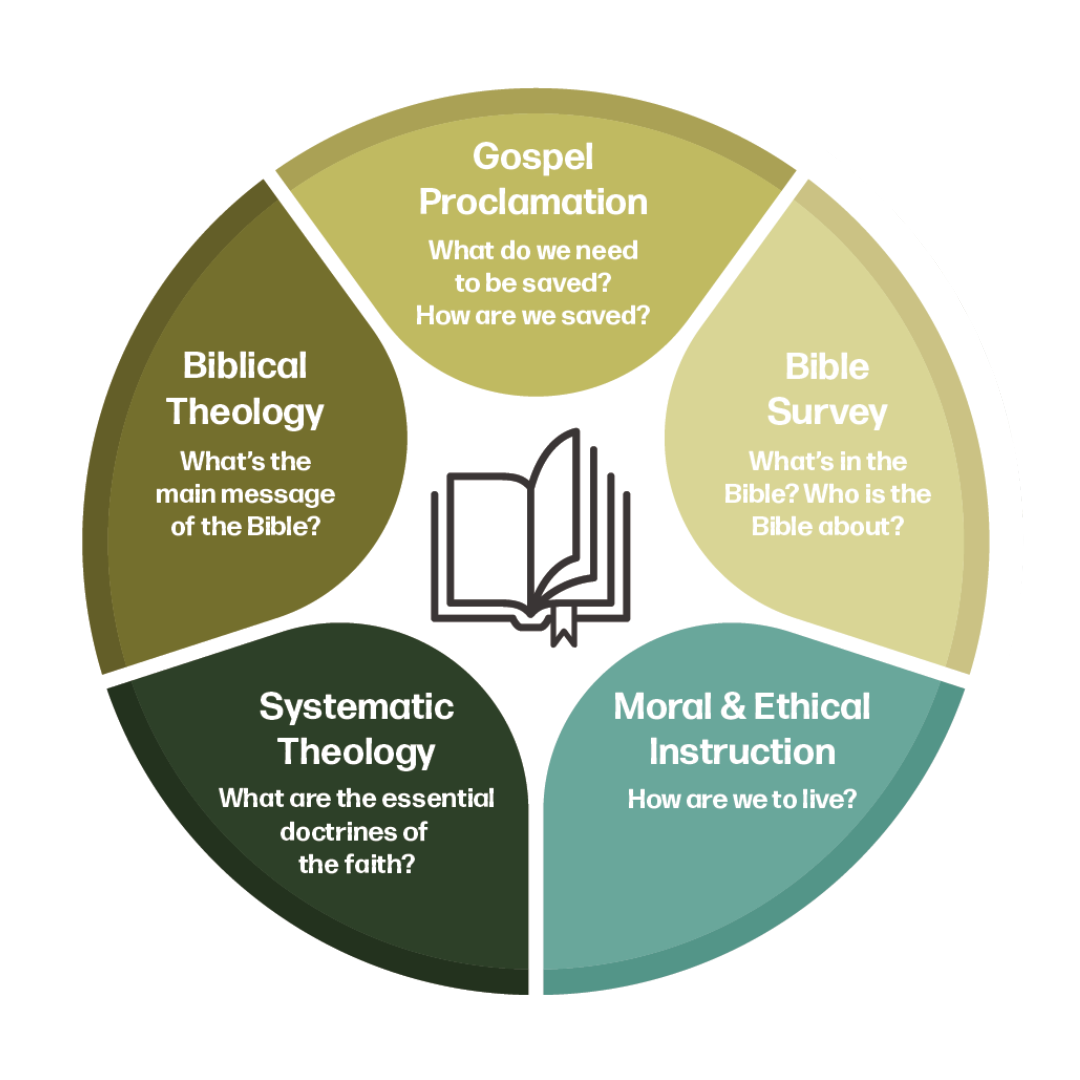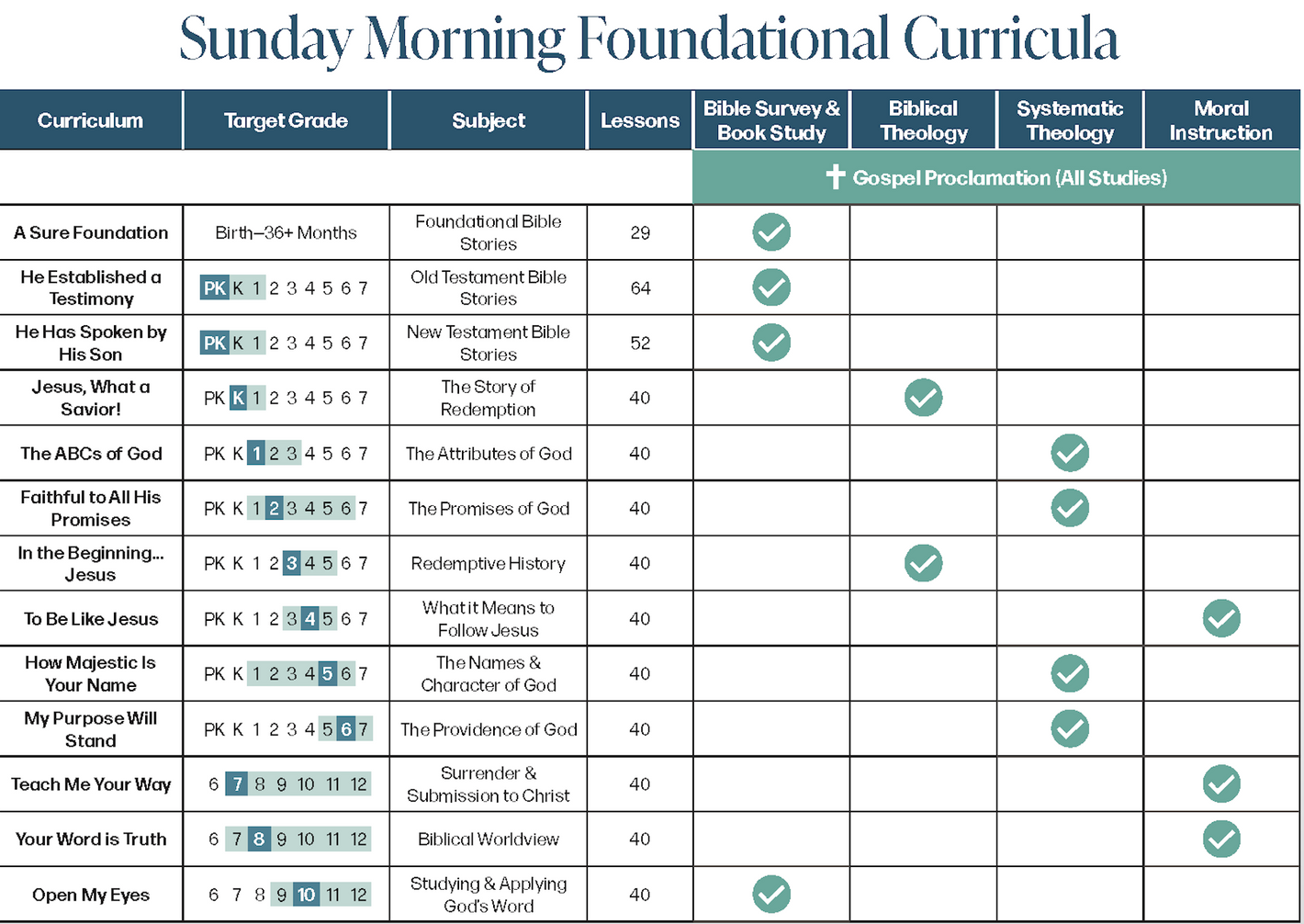Curriculum Scope & Sequence
Scope & Sequence Explanation
Guiding Scriptures
In developing a scope and sequence for our curriculum resources, we have been guided by the following Scriptures:
Therefore I testify to you this day that I am innocent of the blood of all, [27] for I did not shrink from declaring to you the whole counsel of God. [28] Pay careful attention to yourselves and to all in the flock, in which the Holy Spirit has made you overseers, to care for the church of God, which he obtained with his own blood.
ACTS 20:26-28
...from childhood you have been acquainted with the sacred writing, which are able to make you wise for salvation through faith in Christ Jesus. [16] All Scripture is breathed out by God and profitable for teaching, for reproof, for correction, and for training in righteousness,[17] that the man of God may be complete, equipped for every good work.
2 TIMOTHY 3:15-17
Based on these texts and others, we believe Paul is commending to us the importance of teaching the whole counsel of God to the next generation. By the “whole counsel of God,” we may deduce that, at minimum, he is referring to a core knowledge of Scripture that is essential for coming to salvation in Christ and living a life of faith. Therefore, we must make sure that our students have been taught an appropriate breadth and depth of Scripture that will serve to acquaint them with the essential doctrines of the Christian faith.
Teaching the Whole Counsel of God
At Truth78, we have identified and incorporated the following five elements (or theological disciplines) into our scope and sequence. We believe that these five elements, interspersed at different ages and emphasized to varying degrees throughout these ages, comprise an appropriate breadth and depth of Scripture needed for teaching the whole counsel of God. Each element addresses specific and essential questions.

Bible Survey and Book Studies
A chronological overview of the Bible from Genesis to Revelation. In the preschool years, this is accomplished by a story-based presentation that introduces children to the key people, places, events, and themes of the Bible. Most importantly, it emphasizes God as the Author and main character of the Bible. This provides children with a fundamental Bible foundation upon which the other elements will be built. In the older grades, books of the Bible are studied more in-depth.
Biblical Theology
Introduces students to the main storyline of Scripture, whereby God progressively reveals His redemptive purposes, which come to their complete fulfillment in the Person and work of Christ, for the glory of God. Students are taught to see that the Bible’s many diverse stories, written over time, all serve to communicate one main unified message.
Systematic Theology
A topical approach in teaching the foundational doctrines of the Christian faith. Systematic theology presents the Bible’s teaching on various subjects, one at a time, and summarizes each topic based on the entirety of Scripture.
Gospel Proclamation
An explicit presentation of the essential truths of the gospel, leading to a clear understanding of the Person and work of Christ and what it means to respond in true repentance and belief.
Moral and Ethical Instruction
Acquainting students with the nature, role, and importance of God’s laws and commands, the wisdom literature, and the moral and ethical teachings of Jesus and the apostles. This instruction is necessary for understanding God’s character and standards and our need for the gospel, and for guiding believers in righteous and godly conduct.
Teaching Philosophy and Methodology
Though each curriculum has a distinct targeted age range, study focus, and suggested program use (e.g., Sunday School, Midweek Bible, Intergenerational, etc.), all are meant to serve this one main goal:
That the next generations know, honor, and treasure God, setting their hope in Christ alone, so that they will live as faithful disciples for the glory of God.
Toward this common goal, each curriculum incorporates a teaching philosophy and methodology that, in age-appropriate ways, is characterized by the following:
Nurtures Faith
Our aim is to see that children and youth experience true conversion and grow in Christian maturity. Therefore, the curricula are designed to stress an appropriate balance between clearly articulating the essential truths of the gospel and the essence of gospel-living (Christian discipleship). Keeping these two goals in balance will challenge both believing and unbelieving students. Furthermore, it is important to note that, while not every lesson explicitly presents the entire gospel, every lesson presents essential gospel truths. Also, each curriculum as a whole clearly communicates the gospel.
Builds Precept Upon Precept
Just as children are taught the alphabet before they are taught to write words and then sentences, biblical instruction is best grasped when taught incrementally with an intentional, step-by-step, age-appropriate approach. Therefore, much care has been taken in the development of our curricula so that each lesson and each curriculum as a whole builds upon and expands upon the previously learned truths and concepts. This precept-upon-precept approach lays a strong foundation for helping children and youth know and grasp deep truths, and also encourages them to increasingly respond to God’s Word in faith.
Instructs the Mind
If children are to know, honor, and treasure God through Christ, they must become well acquainted with His Word. Toward that end, they must be given the proper tools and skills needed to rightly read, study, interpret, and apply Scripture. Beginning in earnest in first grade, our curricula use an interactive teaching model that guide students to personally engage with the Bible. This model fosters critical thinking and reasoning skills that are important for confidence in and a defense of the Christian faith.
Engages the Heart
While we fully acknowledge that only God can bring Spirit-wrought, grace-dependent faith in Jesus, and lead us to walk as His faithful disciples, we believe that it is our responsibility to guide, inspire, and implore students toward a personal and sincere response to God’s truth. What is learned in the mind needs to transform the heart and will. Therefore, the curricula include elements meant to challenge and graciously entreat students to love, trust, obey, and delight in God.
Influences the Will
We believe that true saving faith will be evidenced by a growing desire to walk in obedience to God. While this is dependent on the work of the Holy Spirit, God does expect His children to exert effort, choosing daily to trust Christ, submit to Him, and follow in obedience. Therefore, each lesson includes Scripture and discussion prompts that guide, challenge, and encourage students to specific Christ-like thoughts, words, and actions. Additionally, these discussions are set in a context of showing the surpassing worth and lasting joy of living life fully surrendered to the perfect will of Jesus.
Understanding the Scope and Sequence Charts
The following scope and sequence charts are designed to help you understand the basics of each curriculum (age, subject, number of lessons) but also the primary theological discipline that provides the main framework for the subject of the study. It is important to note that there is overlap when using these theological labels. For example, no one curriculum is strictly “systematic theology” or “biblical theology.” Also, keep in mind that as the curricula progress from younger to older, each incorporates age-appropriate, interactive Bible study skills into the lesson format. Finally, each chart has the same banner over it: Gospel Proclamation since every curriculum, in its entirety, has been written to emphasize and proclaim the gospel.




Get Started
See how Truth78 curriculum can provide the children in your church with deep and engaging discipleship









